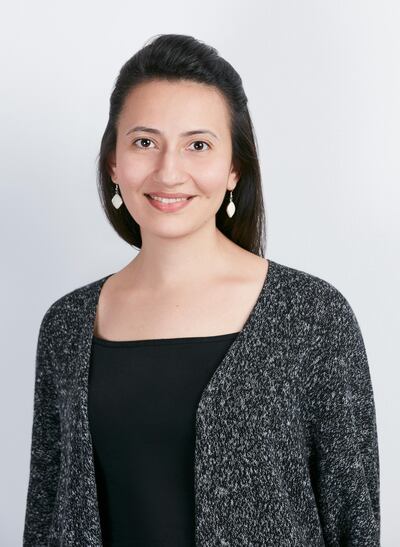Defying category and expectation, Baya Mahieddine charted her own artistic path. More commonly known by only her first name, the self-taught Algerian artist, orphaned at a young age, rose to fame at 16 and went on to become a key figure in Modern Arab art.
Next month, Sharjah Art Museum will present a major retrospective of her work as part of its Lasting Impressions exhibition series, which highlights established Arab artists throughout the ages. “We look at prolific names in Arab art history … they might be famous, but they have not necessarily had a proper retrospective in any Arab museum or institution,” says Alya Al Mulla, a curator at the museum who put together the show alongside Suheyla Takesh, a curator at the Barjeel Art Foundation.
Lasting Impressions: Baya Mahieddine will open on Wednesday, February 24, with more than 70 artworks on display. The show germinated in late 2018 and was postponed from last year owing to the pandemic. In the first half of 2020, the museum carried out the loan process, which brought in works from private collectors and institutions around the world. A few works are also from the collections of Sharjah Art Museum and the Barjeel Art Foundation.
Baya is a fascinating figure partly because of her life story. Born Fatima Haddad in French-occupied Algeria in 1931, she lost her parents at the age of 5 and was raised by her grandmother, a housekeeper at a colonial farm.
When Baya was 11, her grandmother’s employer, a French art collector named Marguerite Caminat, recruited the young girl to be her helper in Algiers and eventually adopted her.
Caminat offered Baya schooling and art supplies, encouraging her to create work. It was through her connections that Baya’s art caught the attention of French dealer Aime Maeght, who put together a solo exhibition of her works in Paris in 1947. Surrealists took notice and Baya, who was only a teenager, was thrust into the art spotlight.
She was soon in the orbit of respected figures such as Andre Breton, Jean Dubuffet and Pablo Picasso. She met Picasso while studying pottery in Vallauris, south-eastern France, and he was impressed with her work.
Baya’s paintings are characterised by central female figures bearing expressive eyes, and occupying the canvas with their august, undulating forms and boldly coloured dresses.
They were often surrounded by elements such as flowers, fruits, feathers and guitars. Baya's works were quick to be labelled as surrealist or naive due to their "child-like" quality, though none of these suited her, as she did not want to be branded with terms from western art.
“In many ways, she was a traditional woman, but she was also radical in how bold, distinct and unapologetic her artistic vision was. Baya had a remarkable certainty about her,” says Takesh.
Throughout her practice, Baya held fast to her motifs of women and nature, eventually incorporating Andalusian musical elements that were inspired by her musician husband.
“You often find that artists are influenced by one another or by the art market, but she had an exceptional confidence in her vision, one that was shaped by her immersion in multiple contexts and cultures, including Amazigh, Arab, Islamic, as well as exposure to European Modernism," Takesh says. "She created something that is so unique, it really shakes up the canon.”
Al Mulla says: “Other artists go through different journeys and different phases in their work, but Baya always did the same thing, which was for her a kind of escape to a happier mindset.”
Baya’s faithfulness to her style is part of her artistic power, setting her apart from her male contemporaries. “She is painting from a woman’s perspective, as an Algerian woman. She is not painting Femmes d’Alger in the way that Picasso did,” says Takesh, referring to the Spanish artist’s series of Cubist paintings of female nudes, which were reportedly inspired by Baya. “With her, you get a representation that is more reliable – one that is not skewed by a male or a colonial lens.”
Later in life Baya expanded her oeuvre to include ceramics and large-scale works, but the motifs – of women and nature – remained. Her characteristic vision informs how the show will unfold – thematically, rather than chronically, connecting the various threads in Baya’s practice.
A unique element to the exhibition is the research material gathered by Al Mulla and Takesh. This includes an interview between Baya and Salwa Mikdadi, an academic and curator who featured the artist’s work in Forces of Change, a major exhibition of female Arab artists, shown in 1994 at the National Museum of Women in the Arts in Washington.
The curators say the interview reveals details about Baya’s personal life in ways that go beyond the fabled narrative of her beginnings. A video of the interview will be screened, and a transcript of an interview between Mikdadi and Manal Ataya, director general of Sharjah Museums Authority, where the two discuss the artist, will be published in the exhibition catalogue. An education programme is also planned to complement the exhibition, plus virtual talks with other institutions involved.
The museum’s retrospective on Baya, who died in 1998, marks the fourth time a female artist has been recognised in the series, which started in 2010. It will also mark the foremost major show of the artist in the region, after her first US solo show at New York University’s Grey Art Gallery in 2018.
Though Baya’s practice paused while she was married and during the Algerian War from 1953 to 1963, she ultimately picked up the brush again and returned to the undaunted female figures she knew. “She never succumbed to critics or society or her peers, and certainly not to categories,” says Al Mulla. “She held her ground, and that’s her legacy.”
Lasting Impressions: Baya Mahieddine will be on view at Sharjah Art Museum from Wednesday, February 24 to Saturday, July 31









